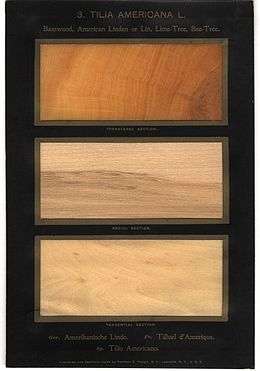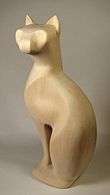Tilia americana
| American basswood | |
|---|---|
.jpg) | |
| Basswoods as street trees in Vancouver, British Columbia | |
| Scientific classification | |
| Kingdom: | Plantae |
| (unranked): | Angiosperms |
| (unranked): | Eudicots |
| (unranked): | Rosids |
| Order: | Malvales |
| Family: | Malvaceae |
| Genus: | Tilia |
| Species: | T. americana |
| Binomial name | |
| Tilia americana L. | |
 | |
| Natural range | |
Tilia americana is a species of Tilia native to eastern North America, from southeast Manitoba east to New Brunswick, southwest to northeast Oklahoma, and southeast to South Carolina, and west along the Niobrara River to Cherry County, Nebraska.[1][2] Common names include American basswood[3] and American linden.
Description
The American basswood is a medium-sized to large deciduous tree reaching a height of 18 to 37 m (60 to 120 ft) exceptionally 39 m (128 ft) with a trunk diameter of 1–1.5 m (3–5 ft) at maturity. It grows faster than many North American hardwoods, often twice the annual growth rate of American beech and many birch species. Total life expectancy is around 200 years, with flowering and seeding generally occurring between 15 and 100 years. Occasionally, seed production may start as early as 8 years.
The crown is domed, the branches spreading, often pendulous. The bark is gray to light brown, with narrow, well defined fissures. The roots are large, deep, and spreading. The twigs are smooth, reddish-green, becoming light gray in their second year, finally dark brown or brownish gray, marked with dark wart-like excrescences. The winter buds are stout, ovate-acute, smooth, deep red, with two bud scales visible.
The leaves are simple, alternately arranged, ovate to cordate, asymmetrical, unequal at the base (the side nearest the branch the largest), 10–15 cm (4–6 in) (can grow up to 25 cm or 10 in) long and broad, with a long, slender petiole, a coarsely serrated margin and an acuminate apex. They open from the bud conduplicate, pale green, downy; when full grown are dark green, smooth, shining above, paler beneath, with tufts of rusty brown hairs in the axils of the primary veins; the small stipules fall soon after leaf opening. The fall color is yellow-green to yellow. Both the twigs and leaves contain mucilaginous sap.
The flowers are small, fragrant, yellowish-white, 10–14 mm (13⁄32–9⁄16 inch) in diameter, arranged in drooping, cymose clusters of 6–20 with a whitish-green leaf-like bract attached for half its length at the base of the cyme. They are perfect, regular, with five sepals and petals, numerous stamens, and a five-celled superior ovary. Flowering is in early to mid summer; pollination is by bees.
The fruit is a small, globose, downy, hard and dry cream-colored nutlet with a diameter of 8–10 mm (5⁄16–13⁄32 in).[1][4][5]
Taxonomy
The circumscription of the species is disputed; some authors[1][6] treat it in a narrow sense, with Tilia caroliniana, Tilia heterophylla, and Tilia mexicana regarded as separate species, while others[2][7][8] treat these as varieties or synonyms of T. americana. The distribution and description above treat the species in its narrow sense; taken in the broad sense, including plants with the leaves white below with dense tomentum (velvety hairs), the distribution extends southwards to Florida, and in Mexico west to Sinaloa and south to Oaxaca.
Ecology
American basswood is dominant in the sugar maple–basswood forest association, which is most common in western Wisconsin and central Minnesota, but occurs as far east as New England and southern Quebec in places that have mesic soil with relatively high pH. It also has minor occurrence in many other forest cover types.
Its flowers provide abundant nectar for insects. The seeds are eaten by chipmunks, mice, and squirrels. Rabbits and voles eat the bark, sometimes girdling young trees. The leaves serve as food for caterpillars of various Lepidoptera (see Lepidoptera which feed on Tilia). The ribbed cocoon maker species Bucculatrix improvisa has not been found on other plants.
This species is particularly susceptible to adult Japanese beetles (an invasive species in North America) that feed on its leaves.[9]
Cultivation and uses

The American basswood can be propagated by cuttings and grafting as well as by seed. The plants grow rapidly in a rich soil, but are subject to the attacks of many insect enemies.
The American basswood is known for being one of the most difficult native North American trees to propagate from seed, as they not only have a low viability rate (approximately 30% of all seeds are viable), but quickly develop an extremely hard seed coating that may delay germination for up to two years. If planting them, it is recommended to gather the seeds in early autumn and sow them before they dry out and form a coating. This will then allow germination to occur immediately. Overall, seeds are not a major part of the tree's reproductive strategy and it instead mostly spreads by self-coppicing. All juvenile basswoods coppice extremely readily, and even old trees will often sprout from the stump if cut.
The American basswood is recommended as an ornamental tree when the mass of foliage or a deep shade is desired; no native tree surpasses it in this respect. It is often planted on the windward side of an orchard as a protection to young and delicate trees.[5] It is cultivated at least as far north as Juneau, Alaska.[10]
The foliage and flowers are both edible, though many prefer only to eat the tender young leaves. It is a beneficial species for attracting pollinators as well. Bees produce excellent honey with a mildly spicy flavor from its blossoms.
Cultivars include 'Nova', 'Duros' (with an upright crown), the pyramidal 'Frontyard' and the conic-crowned 'Redmond'.
Wood

The wood is pale brown, sometimes nearly white or faintly tinged with red; light, soft with fine close grain; clear of knots but does not split easily. It is low in strength and has a poor steam-bending classification. It can take stains and polish without difficulty and it planes, glues, screws and nails well.[11] It is sold generally under the name basswood, but is sometimes confounded with tulip-wood and then called white-wood, and is largely used in the manufacture of wooden-ware, wagon boxes and furniture. It has a density of 0.4525. The wood is considered odorless. This makes it valuable in the manufacture of wooden-ware, cheap furniture, bodies of carriages; it is also especially adapted for wood-carving. The inner bark is very tough and fibrous, used in the past for making ropes.[5]
It is a common wood for use in the production of solid body electric guitars, where it is considered an analogue for aspen and poplar, because it is light, strong and resonant, though it is usually used for guitars that will be painted an opaque color, because its lack of notable grain makes it an unattractive candidate for transparent finish. Linden wood rots easily and old trees have many cavities that serve as nesting places for birds.
Medicinal uses
Although Tilia cordata is believed to be stronger, T. americana is also used medicinally. The dried flowers are mildly sweet and sticky, and the fruit is somewhat sweet and mucilaginous. Linden tea has a pleasing taste, due to the aromatic volatile oil found in the flowers. The flowers, leaves, wood, and charcoal (obtained from the wood) are used for medicinal purposes. Active ingredients in the linden flowers include flavonoids (which act as antioxidants), volatile oils, and mucilaginous constituents (which soothe and reduce inflammation). The plant also contains tannins that can act as an astringent.[12]
Linden flowers are used in colds, cough, fever, infections, inflammation, high blood pressure, headache (particularly migraine), as a diuretic (increases urine production), antispasmodic (reduces smooth muscle spasm along the digestive tract), and sedative. The flowers were added to baths to quell hysteria, and steeped as a tea to relieve anxiety-related indigestion, irregular heartbeat, and vomiting. The leaves are used to promote sweating to reduce fevers. The wood is used for liver and gallbladder disorders and cellulitis (inflammation of the skin and surrounding soft tissue). That wood burned to charcoal is ingested to treat intestinal disorders and used topically to treat edema or infection, such as cellulitis or ulcers of the lower leg.[12][13]
Several animal studies showed that the extract of T. americana increased sleeping time with 50 minutes (similar to the effects of diazepam) and decreased movement, which indicates sedative effects.[13][14] It is argued that its mechanism of action is due to the flavonoid quercetin,[15][16] as it inhibits the release of histamine.[17]
References
- 1 2 3 Crow, T. R. (1990). "Tilia americana". In Burns, Russell M.; Honkala, Barbara H. Hardwoods. Silvics of North America. Washington, D.C.: United States Forest Service (USFS), United States Department of Agriculture (USDA). 2 – via Northeastern Area State and Private Forestry (www.na.fs.fed.us).
- 1 2 "Tilia americana". Germplasm Resources Information Network (GRIN). Agricultural Research Service (ARS), United States Department of Agriculture (USDA).
- ↑ "Tilia americana". Natural Resources Conservation Service PLANTS Database. USDA.
- ↑ USDA NRCS Tree Guide: Tilia americana (pdf file)
- 1 2 3 Keeler, H. L. (1900). Our Native Trees and How to Identify Them. New York: Charles Scriber's Sons. pp. 24–31.
- ↑ Jones, G. N. (1968). Taxonomy of the American species of linden (Tilia). Illinois Biological Monographs 39. Urbana: University of Illinois Press.
- ↑ Hardin, J. W. (1990). "Variation patterns and recognition of varieties of Tilia americana s.l.". Systematic Botany. 15 (1): 33–48. JSTOR 2419014.
- ↑ "Tilia americana ssp. heterophylla". Bioimages.
- ↑ "Managing the Japanese Beetle:A Homeowner’s Handbook" (PDF). USDA.
- ↑ Juneau: Downtown Juneau Tree Guide Archived August 18, 2007, at the Wayback Machine.
- ↑ Porter, Terry (2006). Wood Identification & Use – Revised & Expanded. p. 254.
- 1 2 P, Bradley, ed. (1992), British Herbal Compendium, I, Dorset (Great Britain: British Herbal Medicine Association, pp. 142–144
- 1 2 Aguirre-Hernández, E.; Martínez, A. L.; González-Trujano, M. E.; Moreno, J.; Vibrans, H.; Soto-Hernández, M. (2007-01-03). "Pharmacological evaluation of the anxiolytic and sedative effects of Tilia americana L. var. mexicana in mice". Journal of Ethnopharmacology. 109 (1): 140–145. PMID 16930893. doi:10.1016/j.jep.2006.07.017.
- ↑ Pérez-Ortega, G.; Guevara-Fefer, P.; Chávez, M.; Herrera, J.; Martínez, A.; Martínez, A. L.; González-Trujano, M. E. (2008-03-28). "Sedative and anxiolytic efficacy of Tilia americana var. mexicana inflorescences used traditionally by communities of State of Michoacan,". Journal of Ethnopharmacology. 116 (3): 461–468. ISSN 0378-8741. PMID 18242902. doi:10.1016/j.jep.2007.12.007.
- ↑ Herrera-Ruiz, Maribel; Román-Ramos, Rubén; Zamilpa, Alejandro; Tortoriello, Jaime; Jiménez-Ferrer, J. Enrique (2008-07-23). "Flavonoids from Tilia americana with anxiolytic activity in plus-maze test". Journal of Ethnopharmacology. 118 (2): 312–317. doi:10.1016/j.jep.2008.04.019.
- ↑ Noguerón-Merino, M. C.; Jiménez-Ferrer, E.; Román-Ramos, R.; Zamilpa, A.; Tortoriello, J.; Herrera-Ruiz, M. (2015-04-22). "Interactions of a standardized flavonoid fraction from Tilia americana with Serotoninergic drugs in elevated plus maze". Journal of Ethnopharmacology. 164: 319–327. PMID 25656001. doi:10.1016/j.jep.2015.01.029.
- ↑ Kelly, Gregory S. (2011-06-01). "Quercetin. Monograph". Alternative Medicine Review: A Journal of Clinical Therapeutic. 16 (2): 172–194. ISSN 1089-5159. PMID 21649459.
External links
-
 Media related to Tilia americana (category) at Wikimedia Commons
Media related to Tilia americana (category) at Wikimedia Commons -
 Data related to Tilia americana at Wikispecies
Data related to Tilia americana at Wikispecies